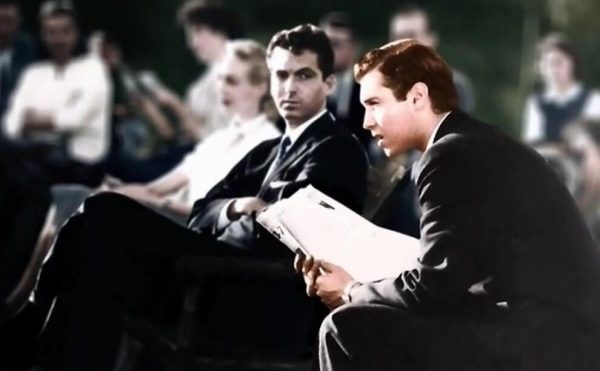Dolls are often considered creepy, especially larger, lifelike dolls. There is a concept in robotics called the uncanny valley which asserts that people are more comfortable with robots that look like humans, but only up to a point. If the similarities are too great, we become uncomfortable. It is not a stretch to apply this concept to dolls. Dolls look like people. They have hair, eyes, fingers, toes and can sometimes blink. I would like to tell the story of a young boy who had an unsettling time with his doll. He had a personal connection with evil, but in reality this evil goes beyond one boy and a doll. His story may have changed the way we have looked at dolls ever since. Afterward I will discuss some of the potential explanations for this uncanny tale.
The Story
Robert Eugene Otto was born to Mr. and Mrs. Thomas Otto in 1900. He was loved, but his parents seemed to lack a personal touch. A maid cared for Robert most of the time. When Robert was four, his caretaker was fired. She left Robert with a forty inch tall doll, designed to model children’s clothes. It was quite lifelike, and Robert loved it. He loved it so much that he named the doll Robert after himself, and began referring to himself as Gene.
Gene loved to take Robert with him everywhere. Robert was a great companion. He was always there when Gene needed a friend to lean on, or someone to talk to. Mrs. Otto would hear Gene talk to Robert throughout the day. She found it delightful that Gene had such a vivid imagination and would interact with Robert as if he was a friend talking back. She had never seen Gene simulate Robert speaking, but she could usually hear two sets of voices come through his door as they would talk and play.
As Gene got older, he insisted Robert be given a seat at their regular family dinner. Eventually, his parents obliged. Robert sat at the table like part of the family. All was well for a time, but circumstances changed. As Gene grew older, his doll seemed to be more… expressive. His face would move ever so slightly. His expression would change just enough to be ignored as the mind playing tricks. Gene became even more insistent that Robert got “his way.” Gene spoke of Robert as if he had a mind of his own. The interesting thing about Robert’s mind, is that Gene didn’t always like what Robert was thinking. Once Mrs. Otto passed by Gene’s door and heard yelling. She listened at the door to a young boy yelling in protest followed by a deep voice. This deep voice carried the weight of something powerful. Mrs. Otto burst through the door. “Is everything alrig-h-t…” she said, tapering off toward the end of the question. Robert was sitting in a small chair in the center of the room. Nightstands were overturned. Curtains were askew. Clothing was thrown about. Furniture was broken. Mrs. Otto turned to find Gene in the corner crying softly,“No, no, no. Robert Did It. He did it, and I couldn’t make him stop.”
Despite the difficulty with Robert, Gene continued to drag him around. As Gene grew, Robert became a chore, but Gene remained insistent Robert got “his way”. Gene’s aunt came to help his parents get rid of Robert. That story would take too long to tell, but the main points are that Gene kept Robert, and Gene’s aunt died quietly in her bed. She died shortly after she locked Robert in the attic. The cause of her death is unknown.
Robert remained at Gene’s side into adulthood. Gene moved away and got married, leaving Robert at the family home. After Genes parents died, Gene returned to his family home and to Robert. His wife told him he needed to get rid of Robert, but Gene reasoned that Robert didn’t like to be alone. She became angry and was mysteriously locked in the bathroom for a whole night. Gene’s whereabouts at the time are unknown. The marriage improved when Robert was moved to a special room that Gene cleaned out and painted for Robert.The room had windows on all sides and is still called the Turret Room. Neighborhood children claimed that the doll would move from window to window, watching the people pass by.
When Gene died, Robert was placed in a cedar box in the Turret Room. The home was rented for a time, but was eventually sold to Mr. and Mrs. Reuter. Myrtle Reuter and her husband were unaware of the crate in the upstairs room. Their young daughter explored the house and found the doll. She became fast friends with Robert. Strangely, the friendship didn’t last. She found the doll to be more lively than the rest of her toys. First, she claimed that the doll would move around the room at night. Then she began to have horrible nightmares. The parents took the doll back to the Turret room. The doll seemed to always find his way back to the room of the young girl. She claimed the doll was trying to hurt her, and she may have been right. After a while Myrtle couldn’t take the doll anymore. In 1994 she took the doll to the Fort East Martello Museum. Robert remains at the museum today.
The museum seems to be a good home for Robert. He is a small celebrity. Families pass through the exhibit, taking fearful looks at the haunted doll. Staff says when he moved into the museum things became eerie. One staff member claims to have catalogued the strange events since Roberts arrival (Video — “Robert Rules After Dark at Ft. East Martello Museum Key West”). Photos are taken of Robert every single day. There is a sign that warns all who enter his exhibit, “Please ask Robert’s permission before taking pictures.” Just above the sign is a monitor which flashes letter after letter written to Robert. The letters are all apologies from past visitors who failed to ask Robert for permission before taking pictures.
“Dear Robert
I am very sorry for not asking your permission to take your picture while visiting the museum last week. Since i have taken your picture without permission many strange things have happened to me.
While driving back from the Keys, a deer ran out in front of our car. We had to swerve to avoid hitting it, and ran off the road. We almost hit a tree. Two days later we had a small kitchen fire. Also, we have been hearing childlike giggles coming from our basement.Last night I was home all alone. I heard a voice coming from the basement. When I went to investigate, I tripped and fell down the bottom three stairs. I got up to run out, but the door was locked. My husband said I probably turned the lock myself without even thinking about it and locked myself in the basement, but honestly, Robert, we both know the truth.
Please accept my deepest apology for taking your picture without asking. Also, please accept my daughter’s apology for sticking out her tongue at you and making fun of you.
Sincerely,
Rosy” (“Victims Letters of Apology to Robert The Doll”)5
I’d like to finish the story with the reason why Myrtle took Robert to the Fort East Martello Museum. Back in 1994, Myrtle and her husband were alone in their home. They may have had a nice dinner or sat on the porch. They may have had a glass of wine, or eaten a delicious steak. They went to bed in their own home, in their own room, safe and sound. They were used to the strange noises of the house and typically slept through them. That night there was a sound. This sound was unfamiliar enough to startle the couple awake. The sound was something Gene’s aunt, Gene’s wife, and maybe even Myrtle’s daughter would have been familiar with. It was the sound of a door opening, and little footsteps moving slowly toward the bed. Myrtle switched on the light in panic. She quickly scanned the room and saw Robert standing upright, at the foot of her bed, knife in hand.
Speculative Explanations
Abuse and Lies
One explanation is that Gene made it up. Maybe Gene was a liar, a really good liar, one whose heart beat with lies, who’s breath was stained with the stench of deception. He would make up voices, throw furniture, and make his parents bend to his will while using Robert as a scapegoat. This is not impossible. Maybe Gene locked his poor wife in the closet, and blamed the doll because it was easy. He may have used the guise of an obsession to preserve his lie. This is all possible, but seems difficult to pull off. From my perspective this would be more trouble than it is worth, but this explanation is still valid.
Psychological Disorder
Anthropomorphism is a condition where someone attributes human-like characteristics to a non-human entity.2 This could be an explanation for the story of Robert the doll. Imagine Gene, alone in his room. He starts talking to the doll and believing in his mind that the doll talks back. Gene could begin to believe this so thoroughly that he starts actually seeing the doll move and hearing it talk back. Maybe Gene really did see the doll moved by a spiritual entity, but maybe Gene was suffering from hallucinations.
Confirmation Bias and Marketing
Regardless of what Gene believed about the doll or why Myrtle didn’t just throw it away, the doll is at the museum now and it is supposedly haunting people. I think this part of the story is easy to explain away with marketing and confirmation bias. Confirmation bias is when people believe something and then use that belief to color their experiences. An example would be Rosy believes she is being haunted, and attributes a deer in the road to a haunting. Deer get in peoples’ way often, and may or may not have been because of a haunted doll. If the museum says to ask for permission before taking pictures, they are encouraging people to take pictures of the doll. If people fail to ask for permission then they may be nervous about the possibility of a haunting, then confirm their haunting by attributing every bad thing to this creepy little doll. The museum is incentivized to perpetuate the haunting of Robert to increase photographs taken and shared.
Spiritual Explanation
The Bible refers regularly to people having or being possessed by a demon. A man in the synagogue where Jesus was teaching had the spirit of a demon (Luke 4:33). There was a man among the tombs who had many demons. The man was strong enough to break chains that people used to tie him up (Luke 8:28). Jesus prevailed over these demons with a word and sent them into pigs.
The Bible never specifically talks about a spirit possessing an object, but it does hint at objects being controlled by demons in some ways. The Israelites were not supposed to bring idols from their conquered lands into their homes so they would not be ensnared by their value, and so they would not be “devoted to destruction” with these objects (Deut. 7:25-26). Dagon the idol falls before the ark of the covenant twice (1 Samuel 5:3-4). This is not specifically stating that Dagon feared God enough to fall before him, but it does give us the possibility that demons may be able to control objects. God may have knocked Dagon down to make a point, but the bible doesn’t say. Satan is the Prince of the Power of the Air which implies his power in this present age (Ephesians 2:1). It is not unquestionable to think that a demon could control an object to ensnare a human, or at least follow an object around and make people believe it is speaking and moving.
Robert being a tool of demonic oppression is a possible explanation. The naturalist would say Gene had a disorder, that his parents fed into it, and he used it to mask violence against his loved ones. They would say Myrtle took the time to donate Robert rather than throw him out and her daughter was lying the whole time about the doll being evil and her nightmares were just coincidence. The naturalist would say Robert is a marketing ploy for a museum to make some extra money and for suburban families to get their dose of fright while road tripping. The idea that all of these things took place together seems a bit far-fetched to me. The naturalistic explanation is possible, but isn’t the only possibility. Robert has been a parasitic member of two families over the course of 100 years and is still claimed to be causing fright in a museum. For some strange reason no one ever threw this dilapidated-looking doll in the trash. The trash is where a weird boy’s old creepy toy belongs. Robert is not in the trash. Robert is in a glass box in Key West. We can go look at it whenever we want, and it seems to act like a demon. Robert is possessive, and demons possess. Robert is violent, and demons are violent (Acts 19:15). Robert wields his power to oppress, and demons wield their power to oppress (Psalm 82).
When we look at how Jesus treated spirits, we see his power over them is total and complete. It is hard to know if Robert is a demonic tool or is exaggerated folklore, but we can know one thing for sure, Jesus is above it. Jesus is above every power and principality. Jesus put them to open shame on the cross. He has taken His seat at the right hand of the father and none can stand against him.
The Facts
Every aspect of this story was found on various websites and articles, they are passed from blog to blog each one adding bits of detail. I told the story as if it were all true because scary stories aren’t interesting otherwise. I wanted to find hard evidence that any of this was real.
The best thing I found was an interview with Malcolm Ross from 1985. Ross met Robert in 1969 because one of his friends rented the house from Gene’s widow. Here is a quote from that interview,
“At first when we walked through the attic door, the look on his face was like a little boy being punished. It was as if he was asking himself, who are these people in my room and what are they going to do to me? – Malcolm Ross” (Eyman).4
Ross continues to describe that Robert appeared to follow the friends conversation, display some kind of intelligence, and even convey “disdain” when Gene’s name is mentioned. Eyman claims the 1985 owners of the house had never heard of Robert which is consistent with the legend that Myrtle didn’t know about the dolls history until after she moved in. Multiple accounts talk of her daughter, but there is no hard evidence of the daughter or the scene with the knife. The legend recounts Robert with a knife at the foot of the bed, but in reality Myrtle claimed she brought the doll to the museum because it moved around her house (Key West Art and Historical Society).1
We know that Robert Eugene Otto was a real person. His art, architecture, and gravesite are easy to find. The Ottos were a fairly prominent family in Key West at the time, and its possible the rumor of their sons doll spread into the folklore we have today. Upon Gene’s death his wife left the doll at the house which was rented out. Robert the Doll was found in Anne Otto’s house by one of her renters after Gene had died. There is no way to corroborate any specific stories about Robert prior to this point. All of it may or may not be true. Things after this point are based on eyewitness testimony. Malcolm met the doll in 1969 and described it to be “intelligent.” After the death of Mrs. Otto, Myrtle bought the house, possibly with her husband and daughter. She brought the doll to the museum because she claimed it moved around her house and was haunted. Robert the Doll is in the Fort East Martello Museum, and people who take pictures without asking will sometimes write letters of forgiveness. This story might be folklore, exaggerated and built upon by different people throughout the last 120 years.
Conclusion
If Robert is all a lie then he is nothing to fear, and if he really is something more sinister, the power of Christ is still overcoming all evil. I really struggled over what to believe after researching this story. There are some facts, and some evidence, but I have no reason to assume validity prior to 1985. I don’t know if Robert really did upheave Gene’s room making him hide in fear or lock his wife in the closet, but for some reason I believe it. The overall behavior ascribed to this evil little thing smells demonic. I know the evidence isn’t detailed enough to draw hard conclusions. But, this isn’t a hard conclusion, it’s a statement of what side of the fence I lean toward. The evidence is just compelling enough for me to tip the scale of my opinion from skeptical to suspicious belief. I believe the bones of the story, but that doesn’t make them facts. The last real fact we know is that this doll is the inspiration for a movie franchise called Child’s Play with the main villain being Chucky the doll. I think the look of Robert, and the tale of Robert is far scarier than any Child’s Play. Maybe you will agree.

Trending
References:
- Key West Art and Historical Society. "A Boy and His doll." Exhibition Description.
- Psychology today. "Anthropomorphism." Definition.
- Clax, Timothy. "Robert the Doll." June 22, 2017, Blog Post.
- Eyman, Scott. "Ghost Houses In Old Key West, The Walls Have Ears -- And Eyes. Here Are Four Guests Whose Names You Won`t See On The Register. But They're There." August 4, 1985.
- Phenomenal Place. "Victims Letters of Apology to Robert The Doll," 4.





















